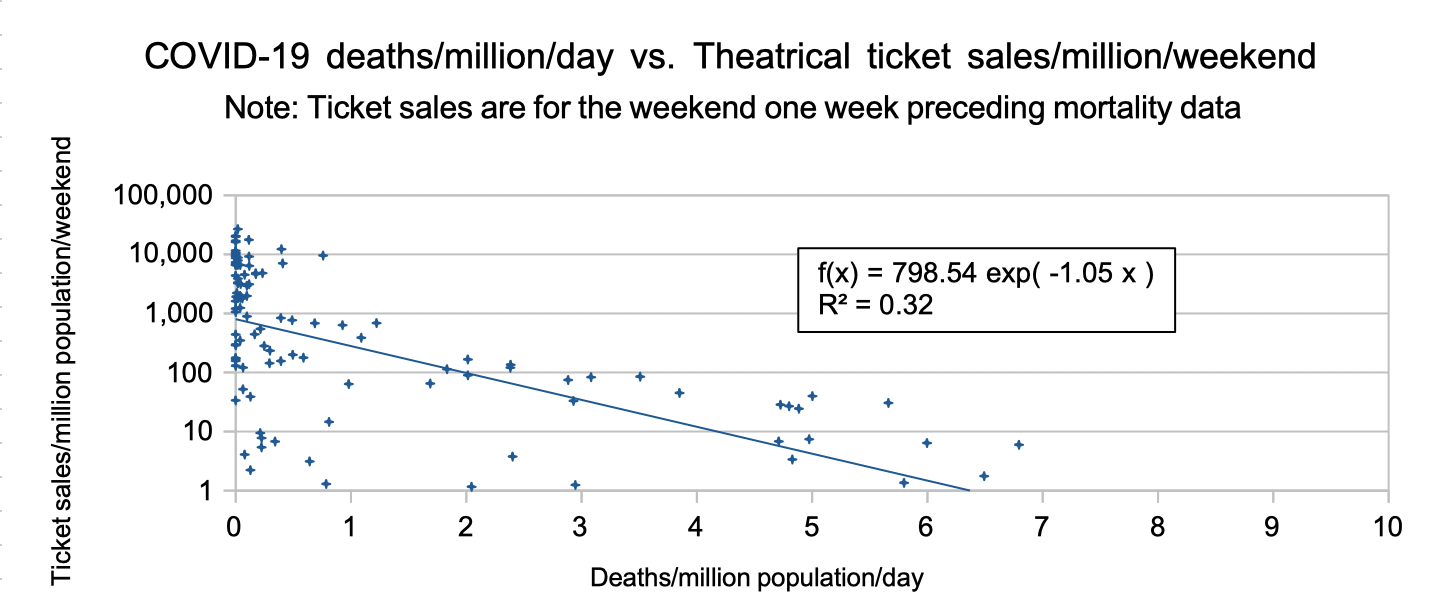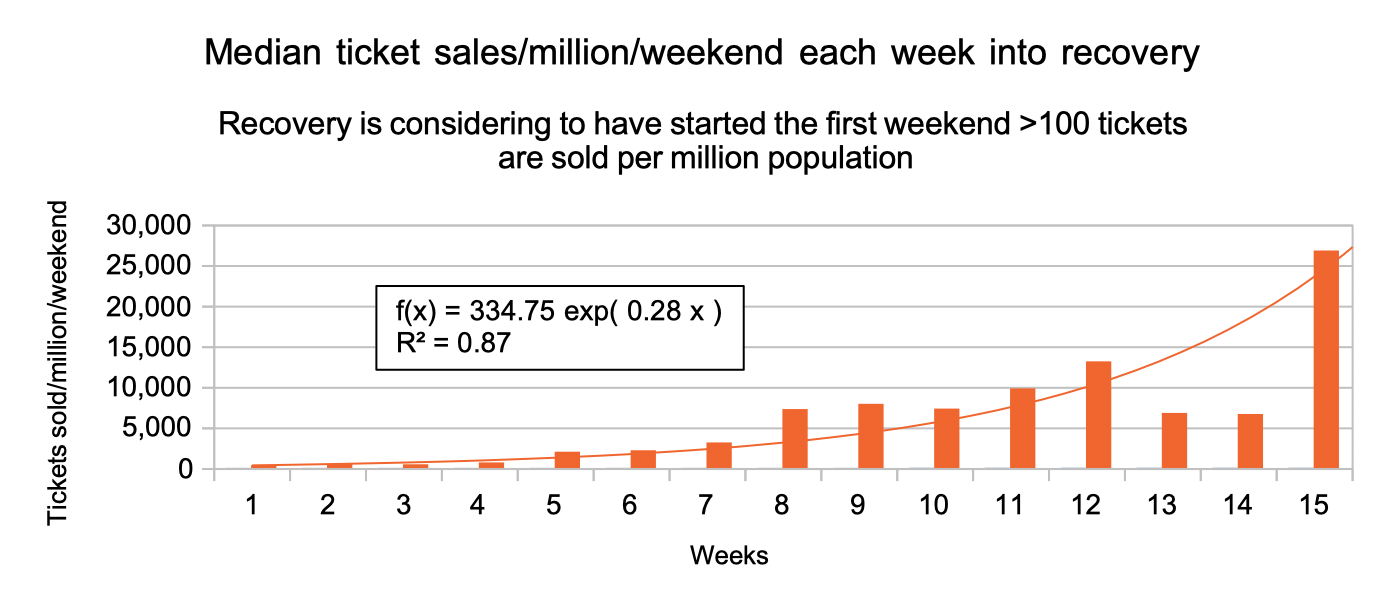August Preview, Part 2: How Quickly Can the Box Office Recover?
August 2, 2020
Warner Bros. dropped blockbuster news about Tenet at the end of July, announcing that the film would debut in 70 international territories starting August 26, and come to as many US theaters as possible on September 3. While it actually isn’t all that unusual for a tentpole release to come out overseas a little before North America—Aquaman did so at the end of 2018, for example—the studio’s decision lays down a marker for how big releases might navigate a world where some countries are slowly recovering from the COVID-19 pandemic, while others, most notably the United States, are conspicuously failing to do so.
In part 2 of this month’s preview, we’ll take a look at how the progress of the pandemic is affecting theatrical ticket sales around the world, how quickly countries are recovering, and what that means for our chances of seeing other blockbuster films coming out soon.
To see how the theatrical market is doing around the world, I have run an analysis of twelve markets that reliably report full numbers each weekend: North America, China, the United Kingdom, Spain, Italy, the Netherlands, Portugal, Turkey, Brazil, South Korea, New Zealand, and Australia. By comparing ticket sales in those countries to the severity of the pandemic, it’s possible to get a sense of how the pandemic is influencing box office.
Before diving into the data, to be clear, I’m not making any recommendations about whether theaters should or should not open, or whether people should go if they do. The analysis is only an attempt to measure how the progress of the pandemic has affected theater attendance and try to draw some lessons about what that means for the future.
The first chart compares weekend theatrical ticket sales to the mortality rate for the disease, with data included for all twelve countries. As one would expect, ticket sales decline as the severity of the pandemic increases, with a daily mortality rate a little over 6 resulting in less than 1 ticket sold per million people, which would translate into around 330 tickets sold in the whole of the United States over a weekend—basically total lockdown. The current mortality rate in the US is around 4 people dying per million population per day, which the model says should translate into about 20 tickets sold/million/weekend, for a total box office around $60,000. The weekend box office in the US is quite a bit more than that (roughly $1 million to $2 million each weekend), but that is largely thanks to the performance of drive-in theaters, which aren’t so badly affected by the pandemic. Even factoring out the income from drive-ins, box office results are slightly better in the US than would be expected if it followed the same pattern as other countries.
At the left-hand end of the chart, where the mortality rate is zero, the model predicts about 800 tickets are sold per million people per weekend (798.54, to be precise). In the US, that would translate into about $2.4 million in total box office for the weekend. Note, however, the huge variation at that low mortality rate, with some weekends recording virtually no sales at all, and others over 10,000 tickets/million people. That variation is the result of two main factors: how much a country is locked down, and how long it is since theaters reopened. We’ll look at those factors in a moment.
One of the key questions with regard to the recovery of the box office is how long the lag is between the number of cases and deaths declining and people’s willingness to return to theaters. In doing the analysis, I found that the closest fit between the mortality rate and ticket sales occurred by plotting the ticket sales against the following week’s mortality rate. i.e., Moviegoers desire to return to theaters looks as though it is slightly ahead of the mortality trend in the pandemic. That might be because the public pays attention to both the case rate and the mortality rate, and the case rate trend is a few weeks ahead of the mortality trend (because cases are generally detected some weeks before people die, if they do). That’s somewhat encouraging news, and means there’s little reason to assume a significant lag between conditions improving and enthusiasm for going to theaters increasing.
To see how the box office recovers once the pandemic is under control and theaters are allowed to open, I’ve plotted the median ticket sales/million each weekend into the recovery for countries that are beginning to reopen. I assume that the recovery started when ticket sales reached 100 tickets per million people, or 1 in 10,000 going to see a movie at the weekend.
There are quite a few peaks and dips in the chart, which is partly due to the timing of the releases of more popular films in individual markets. For example, the release of Peninsula in South Korea significantly boosted the overall box office there a couple of weeks ago. Overall, the trend is quite well modeled by an exponential growth, with box office growing by 32% each week. By week 15 of the recovery, tickets have increased to about 22,000 per million population, which is a little less than half of the “normal” rate of around 50,000 per million.
Since the box office is growing at around 32% a week, which means it doubles every three weeks or so, it might be tempting to assume that it’ll just take another three weeks to go from half the usual box office to 100% of normal. Unfortunately, markets don’t usually behave in this way. Instead, they tend to follow what is often called an S curve: numbers ramp up exponentially to begin with, and then start to level out. If you’d like to learn more on this, 3Brown1Blue has an excellent video that explains exponential growth in the context of the pandemic, and why that evolves into an S curve (also known as the Logistic Curve) over time.
The S curve is familiar to anyone who has studied the evolution of markets. It’s in yellow in this chart, courtesy of Wikimedia:
I think it’s reasonable to assume that the recovery from the pandemic will follow this pattern. A few pioneering theaters will open to begin with, and some braver (or more foolhardy, depending on your perspective) moviegoers will go to them. Over time there will be mass adoption as more theaters open and the general population becomes more confident about going to see movies. At the tail end, some “laggards” will not go back to theaters until they feel completely safe doing so.
One of the neat mathematical features of the Logistic Curve is that once the recovery hits 50% of the population, half the time to complete recovery has passed. Since South Korea has reached about 50% recovery in 15 weeks, a reasonable assumption is that full recovery will take 30 weeks—something a little over six months. Because of the shape of the curve, things will be very close to recovered after about 25 weeks.
So what’s the best case for the United States?
With the exception of the United Kingdom (where the mortality rate was still a relatively high 1.52/million), the recovery kicked off in each country when the mortality rate was well below one person per million, and heading lower. The US is well above that rate right now, at about 3.5/million, and heading higher. The case rate, however, is declining slightly, so the mortality rate should level off or improve in the next few weeks. Assuming it does so, how soon can the theatrical business start to open up in earnest?
The experience of other countries suggests that with an effective response, a mortality rate around 5/million can be brought below 1/million in around 6–8 weeks. If the US behaves like other countries, that would put the beginning of a return to normalcy around mid- to late-September. Full recovery might be hoped for about six months after that, in mid- to late-March, 2021. Having films like Tenet and Wonder Woman 1984 in theaters would help accelerate that process, but their financial viability would be heavily dependent on international markets that are further down the road to recovery.
If full recovery by late March sounds grim, remember it is probably the best case, because it assumes the US will turn the corner soon and recover from the pandemic as quickly as other nations around the world have. So far, the evidence points to the US recovering more slowly, perhaps once an effective vaccine is widely deployed, which is hoped for in early 2021. If that’s the case, then full recovery at the box office probably won’t happen until about this time next year. Right now, the studios have little reason to hold back their movies for the sake of the US market. Focusing on international markets that, barring a second wave, will become more and more viable over the next few months makes the most economic sense. The US theatrical market looks like it will be minimal for quite some time to come.
Notes on methodology:
Data on the pandemic comes from Worldometer. Box office information comes from local film boards, as report in our international tracking section.
While in theory the number of reported cases should provide more fine-grained data than the number of deaths, the reported case rate in each country is highly dependent on the amount of testing being carried out, and how well-targeted that testing is. Most epidemiologists believe that there are many undetected cases in some countries, and the most recent study in the United States suggested about one in ten infections have been identified. The mortality rates, while still imprecise, are more consistent between countries, and can be matched to excess deaths reported by other means to get a sense of their accuracy. In this analysis, I’ve assumed the mortality rate is a good measure of prevalence of the disease. To make a consistent comparison, both the mortality rate and theatrical ticket sales are measured on a per capita basis in each country.
Second, I’m assuming that people in each country are broadly comparable in their tolerance for perceived risk, enthusiasm for being in large crowds, adherence to local, regional, and national laws and guidelines, and so on. There is undoubtedly some variation between countries—a mortality rate of one person per million per day might cause a different response among potential moviegoers in Turkey to what it does in the Netherlands or China, for example—but I assume that these differences are fairly minor in the grand scheme of things. The data mostly supports that assumption, although there are some anomalies, such as China keeping its theaters closed for an extended time in spite of virtually no reported deaths from the disease, and people in the United Kingdom and United States looking slightly more tolerant of risk.
-1-News.jpg)
The effects of the pandemic

The path to recovery


Implications for the United States
Filed under: Monthly Preview, Ban-do


